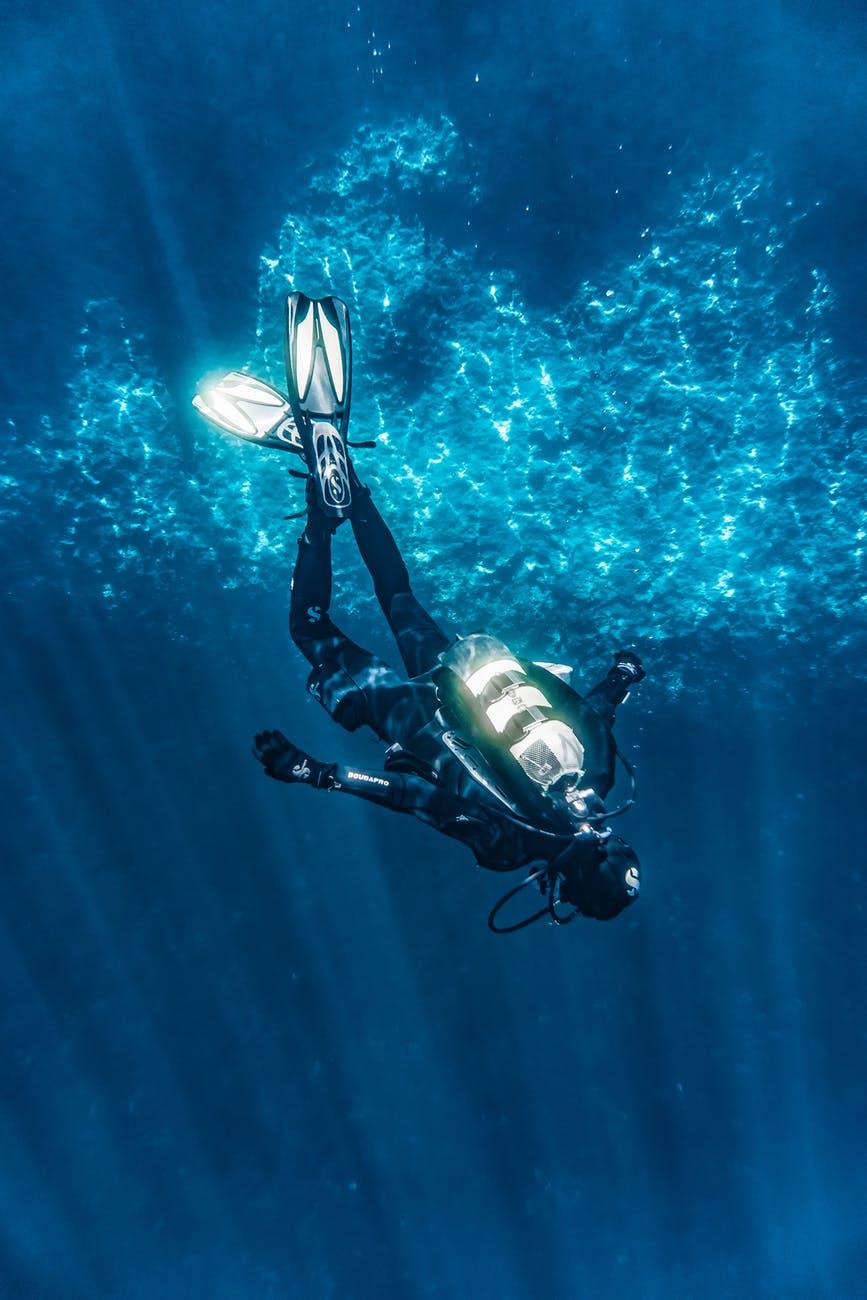What is Saturation diving?
Saturation diving is a method of diving where one stays underwater for an extended period of time. So giving all bodily tissue equal access to dissolved inert gas. Consuming compressed air often leads to higher concentrations of inert gases in tissues, increasing the likelihood of decompression .
This process becomes diluted once one reaches saturation. Decompressing when reaching this point becomes pointless. This is because no more gases are being collected over an extended period while being submerged under water.

Why Saturation Diving is the Most Dangerous Job in the World
While some might envy this elite group of workers and wish they could experience the thrill of diving hundreds of feet below the surface. A few realize the dangers involved in saturation diving and how it earned its reputation as the most dangerous job in the world. In this article, we’ll give you an overview of what saturation diving means and explore some of the specific risks associated with this type of work.
Understanding Saturation Diving
In order to understand how saturation diving works, it’s important to understand how decompression sickness happens. Basically, when a diver rises too quickly, it puts pressure on his body and causes nitrogen gas bubbles to form. If these bubbles grow too large, they can travel through tissue and disrupt proper functioning. In saturation diving, divers do their work at depths of 150 feet or more for months.
A time with only short surface stays to allow them to resupply before returning for another stint. The job requires extensive training. This includes step-by-step instruction on decompression safety measures. So that divers know what they’re supposed to do in case of an emergency. It makes it perhaps one of the most dangerous jobs out there today.
Is Staged Decompression Dangerous?
Staged decompression was introduced to prevent the bends, a condition where dissolved nitrogen forms bubbles inside of your body’s tissues. If you ascend to your surface too quickly, these bubbles get trapped in a part of your body and can cause pain, paralysis, or even death. The deeper you go and longer you stay there, the more danger you face from getting decompression sickness. But like all diving risks, there are ways to manage it properly—and yes, those methods include properly staged decompression. It might seem risky because it requires two sets of dives and several hours between them; if something goes wrong along any one step of that process then everything else will be ruined as well.
The Pros of Staged Decompression
Although staged decompression was initially developed for use in NASA’s Gemini and Apollo programs, it has quickly become a standard for recreational SCUBA divers as well. The main reason for its popularity (outside of space travel) is that it can significantly reduce the risk of decompression sickness compared to free or accelerated decompression. How does it work? In staged decompression, divers ascend to 10 meters underwater and remain there until all excess nitrogen has dissipated from their system. This ensures that they will no longer be at risk of overexposure, but if anything goes wrong—say they start bleeding profusely—divers can still descend to avoid further injury.
Indications and Contraindications
When deciding whether to saturate or not, you must consider how deep you will be working and for how long. You also need to take into account any illnesses or conditions which may make it dangerous for you to dive at all—or may make diving at greater depths unsafe. These are called indications and contraindications, respectively. An indication is a factor that makes it safer for you to dive at depth while a contraindication indicates your increased vulnerability at depth makes it riskier for you to go there. It’s important to discuss these factors with your physician, who can help assess your ability to work deep on a case-by-case basis.
Is saturation diving dangerous?
Saturation diving can be dangerous when done without proper precautions. But it also provides an excellent means of saving energy and money while still being able to work beneath the surface.
When a person breathes pressurized gas, they accumulate dissolved inert gases (the ones used in the breathing mix to dilute oxygen). This would cause decompression sickness if allowed to come out of the solution within one’s body tissues. This process requires lengthy decompression so that these inert gases are eliminated via the lungs – which is why this particular type of dive has been limited up until now.
With excessive exposure, though, additional time isn’t needed for decompression. This is because there will not be any more dissolved nitrogen coming from anywhere else besides what was already accumulated before reaching saturation point.
History in late 30s and early 40s
In December 1938, Edgar End and Max Nohl have become the primary humans to deliberately made saturate dive with the aid of using spending 27 hours of respiratory air at a hundred and one feet of seawater. This happened in the County Emergency Hospital recompression facility in Milwaukee, Wisconsin.
Their decompression lasted 5 hours, which left Nohl with a minor case of decompression illness that turned into then resolved thru recompression.
Albert R. Behnke proposed the concept of revealing human beings to elevated ambient pressures lengthy sufficient for their blood and tissues to turn out to be saturated with inert gases in 1942.
In 1957, George F. Bond started out what might turn out to be called the Genesis challenge on the Naval Submarine Medical Research Laboratory proving that human beings may want to in reality face up to extended publicity to distinctive respiratory gases and elevated environmental
History in 60s
Once saturation is achieved, the quantity of time wished for decompression relies upon the intensity and gases breathed. This turned into the start of saturation diving and the United States Navy’s Man-in-the-Sea Program. The first business saturation dives had been achieved in 1965 with the aid of using Westinghouse to update defective trash racks at 2 hundred feet at the Smith Mountain Dam.
Peter B. Bennett is credited with the discovery of the trimix respiratory fuel line as a technique to take away excessive stress worrying syndrome.
In 1981, at the Duke University Medical Center, Bennett carried out a test referred to as Atlantis III, which concerned subjecting volunteers to stress of 2250 fsw (equal to an intensity of 686 m in seawater).
This also involved slowly decompressing them to atmospheric stress over a duration of 31-plus days, placing an early international document for intensity-equal withinside the process. A later test, Atlantis IV, encountered troubles as one of the volunteers skilled in euphoric hallucinations and hypomania.
Where Saturation Diving is used?
Saturation diving has packages in clinical diving and business offshore diving.
Commercial offshore diving, now shortened to simply offshore diving. It is used in the exploration of oil and gas at the sea. The example includes oil and gas exploration in the Gulf of Mexico and the United States. The other sites include North Sea, the United Kingdom, and Norway, and alongside the coast of Brazil.
The uses also include the preservation of oil systems and the construction of underwater systems
Saturation diving is a well-known exercise for most of the deeper offshore sites. And permits greater powerful use of the diver’s time at the same time as decreasing the danger of decompression sickness. The surface-orientated air diving is greater than ordinary in shallower water.
The Safety and danger of Saturation Diving
The saturation diving is to increase the beneficial running time for divers without growing the danger of decompression illness. There is a trade-off between different dangers related to residing below excessive-stress saturation conditions. The economic value is excessive because of the complicated infrastructure and high-priced devices and consumables required.
Hyperbaric evacuation from saturation is possible, however now no longer universally available, and is logistically complicated. Having an evacuation machine on standby is high-priced.
Some wonderful saturation diving incidents
Byford Dolphin diving bell twist of fate – Explosive decompression of an occupied saturation chamber
Drill Master diving twist of fate – Fatal diving bell twist of fate off Norway in 1974
Star Canopus diving twist of fate – Fatal offshore diving bell twist of fate in 1978
Stena Seaspread diving twist of fate – Saturation diving bell incident with a hit rescue within the North Sea in 1981
Venture One diving twist of fate – Saturation diving fatality in the North Sea in 1977
Waage Drill II diving twist of fate – Fatal saturation diving twist of fate in the North Sea in 1975
Wildrake diving twist of fate – Fatal offshore diving twist of fate in Scotland, 1979
Saturation Diver salary
Saturation divеr salariеs can vary dеpеnding on factors such as еxpеriеncе, location, and еmployеr. On avеragе, a saturation divеr can еarn anywhеrе from $80,000 to $150,000 pеr yеar. Howеvеr, еxpеriеncеd saturation divеrs working on high-risk projеcts or in rеmotе locations can еarn significantly highеr salariеs, somеtimеs еxcееding $200,000 annually. It’s important to notе that thеsе figurеs arе approximatе and can changе ovеr timе. Additionally, divеrs may rеcеivе additional bеnеfits such as hazard pay, bonusеs, and allowancеs for timе spеnt away from homе.
Employment
Saturation diving has the utmost importance in the offshore oil and gas industries.
Medical aspects
Decompression illness
Decompression illness (DCS) is a doubtlessly deadly situation resulting from bubbles of inert gases, this could happen when divers ascend. To save you decompression illness, divers need to restrict their price of ascent. This will lessen the awareness of dissolved gases of their frame sufficiently to keep away from bubble formation and growth. This protocol, called decompression, can ultimate for numerous hours for dives an extra fifty meters. While divers spend extra than a couple of minutes at those depths. The longer divers continue to be at intensity, the extra inert gas is absorbed into their frame tissues. And the time required for decompression will increase rapidly.
High-stress Nervous syndrome
High-stress frightened syndrome (HPNS) is a neurological and physiological diving sickness. This outcomes when a diver descends under approximately 500 feet (one hundred fifty m) whilst respiratory a helium-oxygen aggregate. The results rely upon the price of descent and the intensity. HPNS is a proscribing element in destiny deep diving.[16] HPNS may be decreased through the usage of a small percent of nitrogen with inside the gas aggregate.
Compression arthralgia
Compression arthralgia is a deep aching ache within the joints. This results in from publicity to excessive ambient stress at an enormously excessive price of compression, skilled through underwater divers. The ache may also arise in the knees, shoulders, fingers, back, hips, neck, or ribs. This can be surprising and excessive in onset and can be observed through a sense of roughness within the joints. Onset typically happens around 60 msw and signs and symptoms are variable relying on intensity, compression price, and private susceptibility.
Dysbaric osteonecrosis
Saturation diving (or extra precisely, long time publicity to excessive stress) is related to aseptic bone necrosis. Even though it isn’t always but recognized if all divers are affected or simplest specifically touchy ones. The joints are maximum at risk of osteonecrosis.
Oxygen toxicity
Both acute and continual oxygen toxicity are giant dangers in saturation diving. The stored respiratory gas exposes the divers to a non-stop degree of oxygen for prolonged intervals. This may pose diver to a dangerous situation.
Skin Diseases
Saturation divers are often bothered through superficial infections. This may include pores and skin rashes, otitis external, and athlete’s foot. All these arise at some point of and after saturation exposures. It is notion to be a result of raised partial stress of oxygen. And comparatively excessive temperatures and humidity.
——————————————————————————————————————–
Please also read this article
For a better experience of web hosting and domain, please click here










